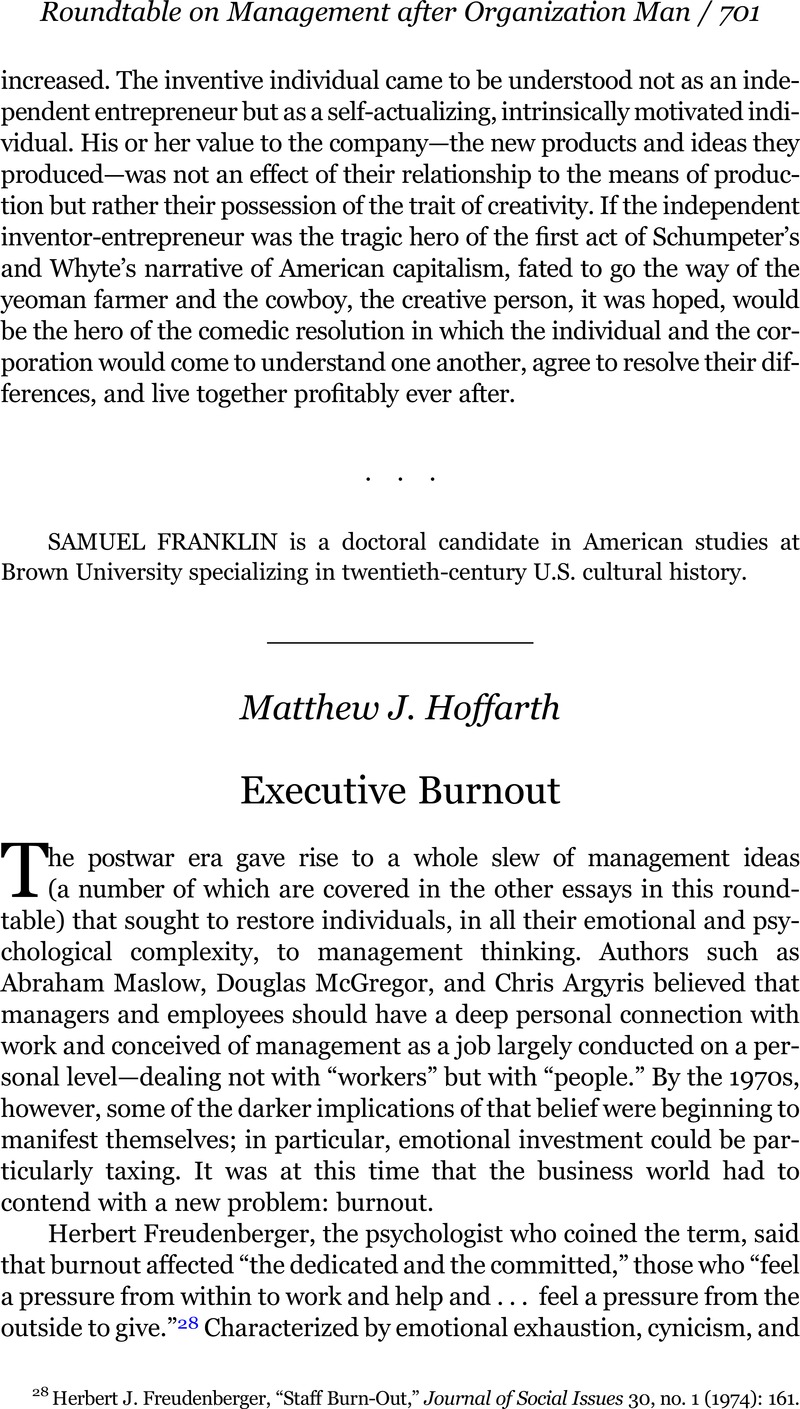
28 Freudenberger, Herbert J., “Staff Burn-Out,” Journal of Social Issues 30, no. 1 (1974): 161 CrossRefGoogle Scholar.
29 See, e.g., Lance Morrow, “The Burnout of Almost Everyone,” Time, 21 Sept. 1981, 84.
30 For works on the history of neurasthenia and stress, see Caplan, Eric, Mind Games: American Culture and the Birth of Psychotherapy (Berkeley, 1998)Google Scholar; Becker, Dana, One Nation under Stress: The Trouble with Stress as an Idea (New York, 2013)CrossRefGoogle Scholar; Viner, Russell, “Putting Stress in Life: Hans Selye and the Making of Stress Theory,” Social Studies of Science 29, no. 3 (1999): 391–410 CrossRefGoogle Scholar; and Watkins, Elizabeth Siegel, “Stress and the American Vernacular: Popular Perceptions of Disease Causality,” in Stress, Shock, and Adaptation in the Twentieth Century, ed. Cantor, David and Ramsden, Edmund (Rochester, N.Y., 2014)Google Scholar.
31 Rebecca Radner, “Burn Out: When You Can't Do Your Job—and Don't Know Why,” BankAmerican, Jan. 1980, 3.
32 Freudenberger, Herbert J., “The Staff Burn-Out Syndrome in Alternative Institutions,” Psychotherapy: Theory, Research and Practice 12, no. 1 (1975): 77, 73CrossRefGoogle Scholar.
33 Ibid., 77.
34 Anxiety about authoritarian leadership became even more conspicuous following the publication of Theodor Adorno et al.’s The Authoritarian Personality in 1950. For works that supported a new vision of leadership, particularly in business, see, e.g., Argyris, Chris, Increasing Leadership Effectiveness (New York, 1976)Google Scholar; Warren G. Bennis, “Revisionist Theory of Leadership,” Harvard Business Review, Jan./Feb. 1961, 26–28, 31, 34, 36, 146, 148, 150; and David C. McClelland and David Burnham, “Power Is the Great Motivator,” Harvard Business Review, Mar./Apr. 1976, 100–110.
35 Maccoby, Michael, The Leader: A New Face for American Management (New York, 1981), 221Google Scholar.
36 Freudenberger, Herbert J., “Burn-Out: The Organizational Menace,” Training and Development Journal 31, no. 7 (1977): 27 Google Scholar.
37 Ibid.
38 Ibid., 26.
39 Ibid., 27.
40 Herbert J. Freudenberger and Geraldine Richelson, “How to Survive Burn Out,” Nation's Business, Dec. 1980, 55.
41 Ibid., 56.
42 Ibid.
43 Harry Levinson, “When Executives Burn Out,” Harvard Business Review, May/June 1981, 73.
44 Ibid., 77.
45 Ibid., 81.
46 Ibid.
47 Excerpted from the credits page of the Spring 1982 issue of California Management Review.
48 Glicken, Morley D. and Janka, Katherine, “Executives under Fire: The Burnout Syndrome,” California Management Review 24, no. 3 (1982): 67 CrossRefGoogle Scholar.
49 Ibid.
50 Ibid., 69.
51 Ibid.
52 Ibid., 72.
53 Ibid.
54 Ibid.
55 Whyte, William H. Jr., The Organization Man (Garden City, N.Y., 1956), 14 Google Scholar.
56 McGregor, Douglas, The Human Side of Enterprise: Annotated Edition (New York, 2006), 75 Google Scholar.
57 Ibid., 74, 102.